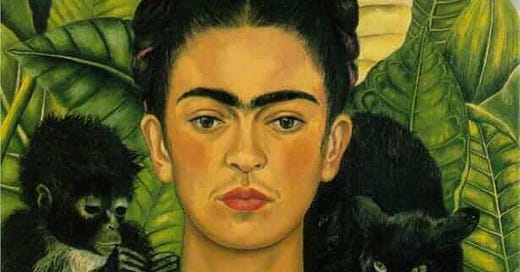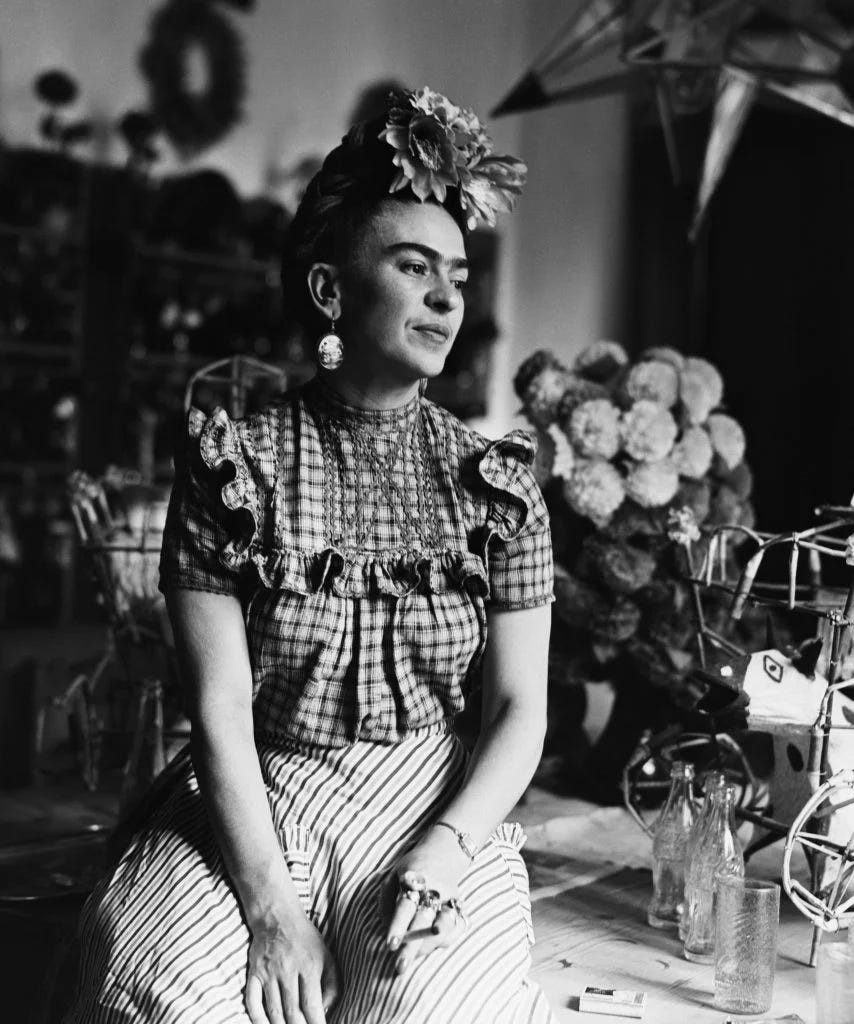Happy Sunday and welcome back to Giselle daydreams! The last few weeks have been intense in my personal life, and I surprised myself to have managed to keep publishing here weekly. However, it was important for me to be able to escape and write about art and cinema. Every time I discover a new artist or reminisce about the artworks of an artist I’m familiar with, watch a good film, browse beautiful homeware accessories, or eat delicious food, I want to share about it. I wish I had the time to do it even more.
Today, I decided to feature Frida Kahlo, an artist I’m truly inspired by in many ways. In the future, I plan to write more essays about her and tell you in more details why she is such an inspiring figure through her personal life and her paintings.
Self-Portrait with Thorn Necklace and Hummingbird is one of Frida Kahlo's most famous paintings, which she created in 1940. It is a powerful and symbolic painting that reflects the artist's inner world and her personal experiences, which are characteristic of Kahlo's introspective and emotive style. She explores several themes that are deeply personal and universally resonant. These themes include suffering, resilience, identity, and the interplay between life and death.
The artist depicts herself at the centre of the painting, staring directly and directly at the viewer with a calm and stoic expression. Her calm yet piercing expression suggests a stoic acceptance of her suffering and a profound strength in facing it. Her gaze is often interpreted as one of strength and resilience despite the pain she endured throughout her life.
Around her neck, Kahlo wears a necklace made of thorns which pierce her skin, drawing small droplets of blood. The thorn necklace evokes the crown of thorns worn by Christ, hinting at themes of sacrifice and martyrdom. Kahlo often depicted herself as a suffering figure, bearing the weight of her pain in a way that echoes religious martyrdom. This theme is further emphasised by her willingness to openly display her suffering and vulnerability, almost as an act of self-sacrifice for her art and for those who view it. Furthermore, this imagery can also be interpreted as a reflection of her physical pain due to numerous health issues, including the severe bus accident she endured, and emotional anguish from her turbulent personal life.
Kahlo’s use of the thorn necklace piercing her skin and drawing blood symbolises a direct portrayal of her own physical and emotional suffering. Her life was marked by chronic pain, and numerous health issues, including the debilitating bus accident and subsequent surgeries. This portrait also reflects her emotional turmoil, particularly the emotional distress from her relationship with Diego Rivera.
Despite the evident pain, Kahlo’s steady gaze and calm demeanour convey strength and endurance. She presents herself as a resilient figure, unflinchingly confronting her hardships. Therefore, this painting encapsulates her ability to endure and survive despite the intense physical and emotional suffering she experienced throughout her life.
A black hummingbird hangs from the thorn necklace. In Mexican folklore, hummingbirds are symbols of good luck and love. However, the lifeless, black appearance of the bird contrasts with this positive symbolism, suggesting themes of death or misfortune instead. Kahlo included a black cat on her left shoulder and a monkey on her right. The cat, traditionally associated with bad luck, witchcraft, and death, looks ready to pounce on the hummingbird. The cat might symbolise impending doom or hidden threats. The lifeless hummingbird and the menacing black cat can be seen as metaphors for her heartache and the emotional scars she bore.
On her right shoulder is a monkey, which often appears in Kahlo's paintings. This particular monkey, a gift from her husband Diego Rivera, adds a layer of personal symbolism. Monkeys often appear in Kahlo's works and are interpreted as playful and affectionate creatures, but in this context, they may also hint at betrayal, mischief or the chaotic aspects of her life.
The butterflies and dragonflies adornments in Kahlo’s hair add an ethereal, surreal quality to the painting. They are commonly regarded as symbols of transformation and the ephemeral nature of life. Their presence in the painting suggests a longing for change and the transient nature of human existence. The dense, lush foliage in the background is a recurring element in Kahlo's self-portraits, symbolising the connection to her Mexican heritage and the natural world. The dense greenery behind provides a stark contrast to the darker, more sombre elements in the foreground, highlighting the duality of life and death, growth and decay.
Kahlo's use of traditional Mexican symbols, such as the hummingbird and lush tropical background, reflects her deep connection to her cultural roots. She often incorporated elements of Mexican folklore and nature into her work, asserting her identity proudly. The surreal quality of the painting, with its dreamlike combination of realistic and fantastical elements, is characteristic of her style and aligns with the surrealist movement, even though Kahlo herself resisted the label.
Kahlo's self-portraits are deeply personal and often reflect her inner turmoil and physical suffering. The painting’s rich symbolism invites multiple interpretations, reflecting Kahlo’s complex inner life. Self-Portrait with Thorn Necklace and Hummingbird can be seen as an exploration of Kahlo's own metamorphosis through her experiences of pain, resilience, and self-discovery.
This particular painting, with its vivid and stark imagery, can be seen as a representation of her pain and endurance. The thorn necklace and the lifeless hummingbird signify suffering and thwarted aspirations, while the presence of the cat and monkey adds layers of complexity to her emotional state and relationships. The hummingbird’s position and colour add to the painting's sense of unease and complexity, possibly representing crushed hopes or unattainable desires. The butterflies and dragonflies might indicate her hope for transformation and transcendence despite her suffering. The juxtaposition of life (butterflies and lush foliage) and death (thorn necklace and the lifeless hummingbird) as well as the interplay of different animals, adds depth to this portrait, making it a powerful expression of her personal narrative and broader existential themes.
Kahlo suffered from lifelong health issues, including a severe bus accident when she was 18 that led to numerous surgeries and chronic pain. Her health issues are central to understanding the themes of pain and resilience in her work. Her tumultuous marriage with Rivera was marked by infidelity and heartbreak, which deeply influenced her emotional turmoil and artistic life, often serving as a source of both inspiration and anguish. Kahlo’s work is infused with Mexican cultural elements and nature, reflecting her deep connection to her roots, emphasising her pride in her heritage, and her desire to assert her identity.
Self-Portrait with Thorn Necklace and Hummingbird stands as a testament to Frida Kahlo’s ability to convey profound emotion and complex themes through vivid and often surreal imagery. This painting, like many of Kahlo's works, offers a window into her soul, blending personal pain with rich cultural symbolism. It is a multi-layered work which encapsulates Kahlo's personal narrative and broader existential themes. It is a powerful meditation on suffering and resilience, identity and cultural pride, life and death, and the constant flux of transformation. Through this painting, Kahlo not only shares her deeply personal story but also connects with universal human experiences, making her work enduringly relevant and poignant.
“They thought I was a Surrealist, but I wasn’t. I never painted dreams. I painted my own reality.” — Frida Kahlo
I hope you enjoyed today’s post. Please keep liking, commenting, subscribing and sharing. It helps the newsletter grows. If you would like to support this project and can afford to do so, please consider becoming a paid subscriber.
See you next Sunday for the last volume of my cinema series featuring five films set in Italy.
Giselle xx








I was reading this at work because I was so drawn into the painting and your analysis. I’m not always as big of a Frida fan as I want to be, but when she hits she hits, and you’ve given me another reason to love her. Lovely post!
Wow, I don't know if I've ever seen the Kahlo portrait of her wearing the hummingbird necklace + it is stunning.